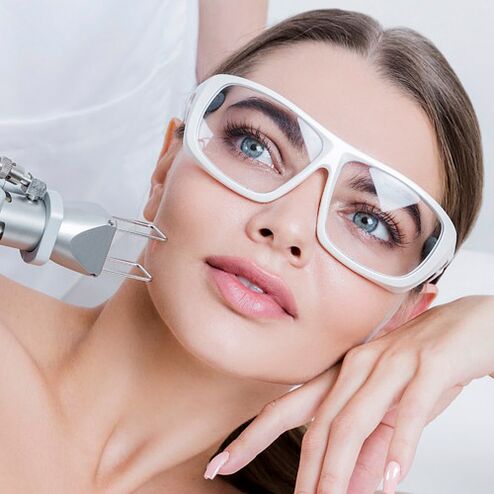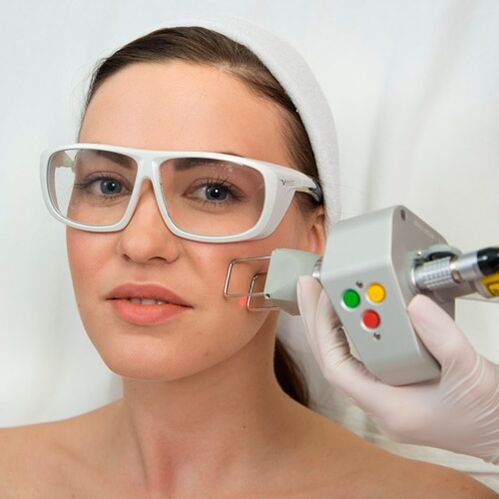Fractional laser rejuvenation- a cosmetological procedure in which the skin is exposed to a laser array of micro-rays. The purpose of this effect is to activate regeneration processes and collagenogenesis. This is a relatively new, but already very popular hardware technique. In another way, it is called fraxel, fractional laser surface or photothermolysis.

Principle of operation and types of fractional laser rejuvenation
How does a fractional laser work? The micro-rays emitted by the device cause a heat shock, and in response, "lazy" skin cells begin to become more active. They split faster to repair the damaged area. Old cells that appear to be inoperable die, giving way to young ones. Warming of the deeper layers of the skin is accompanied by partial denaturation of proteins, as well as the formation of new components of the extracellular matrix, including elastin and collagen.
The depth of impact variesablative and non-ablative laser rejuvenation. . . The first is superficial and resembles grinding. Laser treatment of the upper layers of the skin is accompanied by evaporation of moisture, damage to the epidermis. After healing, the skin becomes more toned, the relief and color are corrected. During non-ablative photothermolysis, the laser affects the deeper layers of the skin. In this case, no open wounds are formed.
Every kind of rejuvenation has its advantages and moments. Thus, the effect of the ablative laser surface is noticeable after the first procedure. Using this method, you can get rid of deep wrinkles and age spots, post-acne, stretch marks, scars. There is no risk of infection with a non-ablative procedure, and the anti-aging effect lasts for several years. This type of photothermolysis is recommended for people under the age of 40 with the first signs of aging: fine wrinkles, reduced turgor.

Tips and contraindications for the procedure
It is worth resorting to the procedure of photothermolysis in the following cases:
- Lightness, sagging skin.
- Both fine and deep wrinkles, crow's feet.
- Pigmentation of any origin.
- Increased sebum secretion.
- Enlarged pores, prone to acne.
- Wounds, stretch marks, after acne.
- Vascular "stars" (rosacea).
- Dull skin.

Contraindications to fractional laser rejuvenation are:
- Allergies, psoriasis.
- Autoimmune diseases.
- Pregnancy, breastfeeding.
- Blood diseases.
- Skin infections, inflammation in the intended treatment area.
- Any chronic disease in the stage of decompensation.
- Oncology.
- Increased body temperature.
- Diabetes.
- The tendency to form keloid scars.
- Epilepsy.

Features of laser rejuvenation
Preparation for the fractional photothermolysis procedure consists of refusing to visit the solarium and the beach for two weeks. During all this time, you can not clean the skin, do chemical peels, take sulfonamides, fluoroquinolones, tetracyclines. Three days before the procedure, they stop going to the pool, bath, sauna, treat the suspected area with alcohol cosmetics. To prevent complications, the cosmetologist may prescribe antiviral and antibacterial drugs for this period. One day before the procedure, it is necessary to refrain from going to the gym without alcohol and smoking.
Before laser treatment, the skin is cleansed of cosmetics and impurities. Generally, the effect of the laser is felt as an unpleasant tingling sensation, but sometimes a pain reliever may be required. In this case, the cosmetologist applies anesthesia to the prepared skin area. After applying the ointment, the skin continues to be treated with laser. The duration of the procedure depends on the area of treatment and ranges from a few minutes to an hour. Finally, soothe the skin with a nourishing cream.
In the first days after the procedure, you can not use alcohol-containing products, you can not compress the parts of the body where photothermolysis is performed with a compressed canvas. It is recommended to exclude physical activity for a week, visit the pool, sauna or bath, limit the time spent on the street. Moisturizes skin with a special cream three times a dayAnd so half a month. It is undesirable to use cosmetics containing peat, retinol, salicylic acid. It is necessary to use a cream with a sun protection factor of 35 or more for two months.

How many procedures do you need to get the result? What effect can be expected?
Rehabilitation period after laser fraction rejuvenation lasts from 3 to 7 days. The speed of recovery depends on your lifestyle. Alcohol consumption, smoking, overactivity, unbalanced diet, insomnia and anxiety - all of these can slow down the regeneration process.
Redness and slight swelling of the skin may be observed in the first three days after laser exposure. Anesthesia and cooling of the skin can help reduce anxiety. If the skin feels shrinking within a week, there are stained areas. A side effect of the procedure may be a spontaneous bronze tanning after half a month.
After fractional photothermolysis, a lasting result occurs after 2-5 procedures. More precisely, the number of sessions can be determined by a cosmetologist only on the basis of preliminary data. The intervals between procedures are 3-4 weeks. Fractional laser rejuvenation inhibits the aging process: wrinkles disappear or become less noticeable, turgor increases, pores become less severe and complexion improves. This method is an effective tool in the fight against scars, pigmentation, post-acne, stretch marks.
Fractional laser rejuvenation is one of the most widely used apparatus cosmetic procedures. Its advantages include efficiency, short treatment time, physiology. The result is visible after the first procedure and lasts up to three years. The method has a wide range of indicators. It is possible to choose the depth of laser exposure.
























